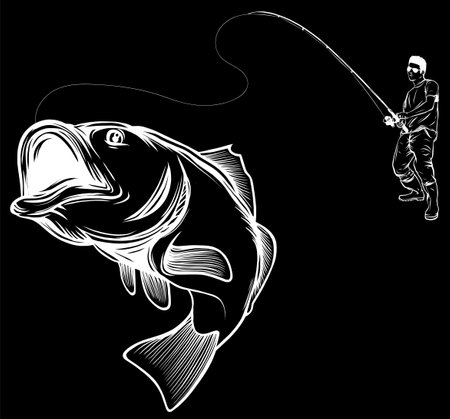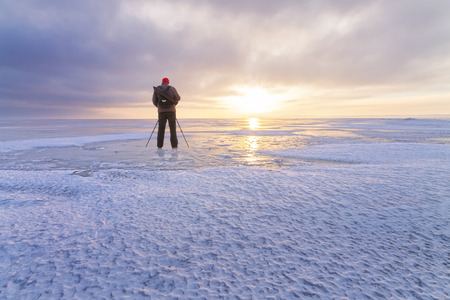1. Introduction: Embracing the Ice Fishing Tradition
Ice fishing is more than just a winter pastime—its a beloved tradition that brings together anglers across the United States, from Minnesota’s frozen lakes to upstate New York and the vast icy waters of the Midwest. As temperatures drop and lakes freeze over, passionate fishermen and families alike bundle up, drill their holes, and set out for an adventure that’s as much about camaraderie and nature as it is about the catch.
But success on the ice isnt just about patience or luck. The gear you bring can make all the difference between a chilly day spent waiting and one filled with excitement and prize-worthy fish. Among all your equipment, choosing the right ice fishing rod is especially important. The perfect rod helps you feel even the faintest bite through thick ice, gives you control over your line, and lets you handle everything from tiny panfish to trophy-sized walleye or pike.
Why Is the Right Ice Fishing Rod So Important?
The unique conditions of ice fishing call for specialized rods. Cold weather, smaller holes, and limited movement mean your rod needs to be sensitive yet strong, compact but comfortable to hold for hours. Here’s a quick look at why picking the best rod matters:
| Reason | How It Impacts Your Experience |
|---|---|
| Sensitivity | Helps detect subtle bites under thick ice |
| Durability | Withstands freezing temps and tough fights with big fish |
| Comfort & Grip | Keeps your hands warmer and less fatigued during long sessions |
| Size & Portability | Makes it easy to transport your gear out onto the lake |
| Targeted Species | Certain rods are better suited for specific types of fish (like perch vs. lake trout) |
The All-American Ice Fishing Experience
Across America’s northern states, ice fishing isn’t just about catching dinner—it’s about making memories in the great outdoors. Whether you’re sharing stories in a heated shanty or watching tip-ups flutter in the wind, having the best ice fishing rod ensures every moment is enjoyable. In this guide, we’ll help you explore top choices for rods that match your style, needs, and budget so you can make every cold-weather angling trip a true adventure.
Key Features to Look for in an Ice Fishing Rod
When you’re gearing up for some serious ice fishing during a chilly American winter, picking the right rod is crucial. Not all rods are built to handle freezing temps, thick ice, and finicky fish. Here’s what you need to know about the key features that make a great ice fishing rod.
Rod Length
Ice fishing rods are usually much shorter than open-water rods, typically ranging from 18 to 36 inches. The right length depends on your fishing style and shelter space:
| Rod Length | Best For |
|---|---|
| 18″–24″ | Tight quarters like ice shanties, kids, or ultra-light panfish setups |
| 24″–28″ | All-around use; good mix of sensitivity and power for most species |
| 28″–36″ | Bigger holes or outside fishing; more leverage for larger fish like walleye or pike |
Material Matters
The material of your rod affects durability, weight, and how well you can feel bites under the ice. Here’s a quick breakdown:
| Material | Pros | Cons |
|---|---|---|
| Fiberglass | Tough, forgiving, affordable—great for beginners and big fish | Slightly less sensitive than graphite |
| Graphite/Carbon Fiber | Super sensitive, lightweight—ideal for detecting light bites from panfish or trout | Can be more brittle in extreme cold if not handled carefully |
| Composite (Mix) | Balanced combo of strength and sensitivity; versatile option | Might cost a bit more but offers best-of-both-worlds performance |
Sensitivity: Feel Every Nibble
Icy waters mean sluggish fish. Sensitivity is key to noticing those subtle bites. Graphite rods generally offer better sensitivity, while fiberglass rods provide more forgiveness when you set the hook on a trophy catch.
Why Sensitivity Matters:
- Panfish often nibble lightly—high sensitivity helps you react fast.
- Bigger fish may bite gently in frigid conditions.
- A sensitive tip lets you differentiate between a bite and hitting the bottom.
Handle Design: Comfort and Control in the Cold
The handle of an ice fishing rod isn’t just about comfort—it also affects grip when wearing gloves or mittens. Common handle materials include cork, EVA foam, and rubberized grips.
| Handle Material | Main Benefit |
|---|---|
| Cork | Warm to the touch; classic feel with good feedback from the rod blank |
| EVA Foam | Cushiony and non-slip even when wet; easy to hold with gloves on |
| Rubberized Grips | Ultra-grippy in icy conditions; durable and easy to clean after a day on the ice |
Pro Tip:
If you fish outside without a shelter, go for handles that are thick enough for gloved hands but not so bulky they reduce control. Some rods also have ergonomic shapes or cutouts for better finger placement and direct blank contact.
Summary Table: Key Features at a Glance
| Feature | What to Look For? |
|---|---|
| Length | Suits your shelter space & target species size |
| Material | Sensitivity vs. strength balance (graphite/fiberglass/composite) |
| Sensitivity | Able to detect even softest bites in cold water conditions |
| Handle Design & Material | Cork/EVA/rubberized for warmth & grip with gloves on; ergonomic shape preferred for comfort during long sessions |

3. Top Ice Fishing Rods on the Market
If you’re planning to hit the ice this winter, choosing the right rod can make all the difference between a fun day and a frozen disappointment. American anglers know that not all rods are built alike—especially when it comes to cold-weather fishing. Here’s a look at some of the best ice fishing rods available today, what sets them apart, and why they’re favorites in the U.S.
KastKing Konvert Twin Tip Ice Rod
This rod is a top pick among American anglers because of its unique twin-tip design, letting you switch between a medium-light and medium action tip. It’s lightweight, sensitive enough to detect even the lightest bites, and strong enough for bigger catches like walleye or pike.
- Standout Features: Two interchangeable tips, graphite construction for extra sensitivity, comfortable EVA handle
- Why Anglers Love It: Versatile for different species and great value for the price
13 Fishing Tickle Stick
The Tickle Stick is famous for its flat tip design, which helps you spot subtle strikes—a must when fish get sluggish in cold water. The solid Toray blank delivers exceptional sensitivity while reducing line twist and memory.
- Standout Features: Flat tip technology, high-quality guides, custom reel seat
- Why Anglers Love It: Super sensitive and perfect for finesse presentations when panfish are finicky
St. Croix Mojo Ice Rod
The Mojo series is trusted by many American ice anglers thanks to its premium construction and wide range of lengths and actions. Whether you’re targeting bluegill or lake trout, there’s a Mojo Ice rod that fits your needs.
- Standout Features: Premium SCIII carbon blank, split-grip cork/EVA handle, tailored actions for various species
- Why Anglers Love It: Durable build with excellent feel and control; made by a respected American brand
Quick Comparison Table: Top Ice Fishing Rods
| Rod Model | Main Feature | Best For | User Favorite Reason |
|---|---|---|---|
| KastKing Konvert Twin Tip | Twin-tip versatility (medium-light & medium) | Multi-species angling | Switchable tips & budget-friendly |
| 13 Fishing Tickle Stick | Flat tip for bite detection | Panfish finesse fishing | Sensitivity & unique design |
| St. Croix Mojo Ice Rod | Premium carbon blank; multiple actions/lengths | Panfish to lake trout | Quality construction & range of options |
Other Noteworthy Mentions:
- Berkley Cherrywood HD Ice Rod: Affordable and reliable—perfect for beginners or as a backup rod.
- Fenwick Elite Tech Ice Rod: Known for its balance of strength and sensitivity, making it ideal for targeting larger species under the ice.
No matter which rod you choose, these favorites have earned their place in countless ice shanties across America for good reason—they perform when it matters most on those frigid winter days.
4. Matching Your Rod to Your Target Species
If you want to catch more fish and have more fun on the ice, picking the right rod for your target species is key. Not all ice fishing rods are created equal—different fish need different rod actions and powers to get the job done. Here’s a quick guide to help you match your rod to popular cold-weather favorites in American waters.
Walleye
Walleye are known for their light bites and strong runs. For these prized fish, look for a medium-light to medium power rod with a fast action tip. This combo gives you sensitivity to detect those subtle hits but still enough backbone to set the hook and fight a big one through the ice.
Recommended Specs:
| Species | Rod Power | Action | Length |
|---|---|---|---|
| Walleye | Medium-Light/Medium | Fast | 26”–30” |
Perch & Panfish (Bluegill, Crappie, Sunfish)
Panfish and perch have softer mouths and don’t put up as much of a fight as bigger gamefish. Go for an ultralight or light power rod with an extra-fast or fast action tip. This setup lets you feel every nibble and keeps you from tearing hooks out of these smaller fish.
| Species | Rod Power | Action | Length |
|---|---|---|---|
| Perch/Panfish | Ultralight/Light | Extra-Fast/Fast | 22”–28” |
Trout (Rainbow, Brown, Brook)
Trout can be aggressive but also require finesse. A light to medium-light rod with a fast action tip is ideal for detecting delicate strikes and controlling the fight, especially in clear water where trout might be wary.
| Species | Rod Power | Action | Length |
|---|---|---|---|
| Trout | Light/Medium-Light | Fast | 24”–30” |
A Quick Comparison Chart for Common Species:
| Target Fish | Rod Power & Action Combo | Main Benefit |
|---|---|---|
| Walleye | Medium-Light/Fast Action | Sensitivity & Hooksetting Power |
| Panfish/Perch | Ultralight/Fast or Extra-Fast Action | Tiny Bite Detection |
| Trout | Light/Fast Action | Bite Sensitivity & Control |
A Few Tips:
- If you’re mostly after one species, tailor your rod choice to that fish.
- If you want to chase everything from bluegill to walleye, consider a versatile medium-light rod with a fast tip.
- The length of your rod matters too: Shorter rods are great in tight ice shacks, while longer ones offer better leverage on bigger fish outside.
- The right reel pairing and line choice will also help you land more fish, so keep that in mind when gearing up!
Selecting the right ice fishing rod based on your local waters and favorite species makes every trip more enjoyable—and helps you bring home more fish!
5. Tips for Success and Safety on the Ice
Maximizing Your Ice Fishing Rod’s Performance
Getting the most out of your ice fishing rod can make your cold-weather angling adventures more fun and rewarding. Here are some easy tips to help you fish smarter, not harder:
- Pick the Right Rod for the Job: Match your rod power and length to the species you’re targeting—light rods for panfish, medium or heavy rods for walleye and pike.
- Use Sensitive Rods: In freezing temps, fish can be less aggressive. Sensitive rods help you feel those light bites under the ice.
- Keep Line Guides Ice-Free: Dip rod tips in the water occasionally or use a little line conditioner to prevent ice build-up.
- Keep Your Setup Simple: Fewer knots and hardware mean less that can freeze up or break when it gets really cold.
Maintaining Gear in Subzero Temps
Cold weather is tough on gear. Take care of your rods and reels so they last all season long:
| Tip | Description |
|---|---|
| Dry Off After Use | Wipe down rods and reels after each outing to avoid moisture freezing on your equipment. |
| Lubricate Moving Parts | Use cold-weather reel grease to prevent gears from seizing up in extreme temps. |
| Store Properly | Keep rods and tackle in a heated space overnight to prevent cracking or warping. |
| Avoid Over-Tightening | Tightened parts can become brittle in subzero conditions. Go easy to prevent breakage. |
Staying Safe on American Frozen Lakes
Your safety always comes first when ice fishing. Here are some must-follow rules for staying safe while enjoying frozen lakes across the U.S.:
- Check Ice Thickness: Always make sure there’s at least 4 inches of clear, solid ice before walking out—more if you’re bringing an ATV or snowmobile.
- Fish with a Buddy: Never go out alone. It’s safer (and more fun) with a friend watching your back.
- Wear the Right Gear: Insulated boots, waterproof gloves, and layers will keep you warm and dry even on the coldest days.
- Carry Safety Equipment: Bring along ice picks, a throw rope, and a life vest just in case you need them.
- Avoid Alcohol: Save the celebration for after you’re off the ice—alcohol can increase your risk of hypothermia and slow reaction times.
Your Ice Fishing Essentials Checklist
| Item | Why You Need It |
|---|---|
| Sensitive Ice Rod & Reel Combo | Catches more fish by detecting subtle bites |
| Iced Line & Tackle Box | Keeps lures and bait ready for quick changes |
| Icepicks & Throw Rope | Essential safety tools if you fall through ice |
| Sled or Bucket Seat | Makes transporting gear easier and provides seating |
| Insulated Clothing Layers | Keeps body temperature stable all day long |
| Packed Snacks & Warm Drinks | Makes those long days on the lake much more enjoyable! |


